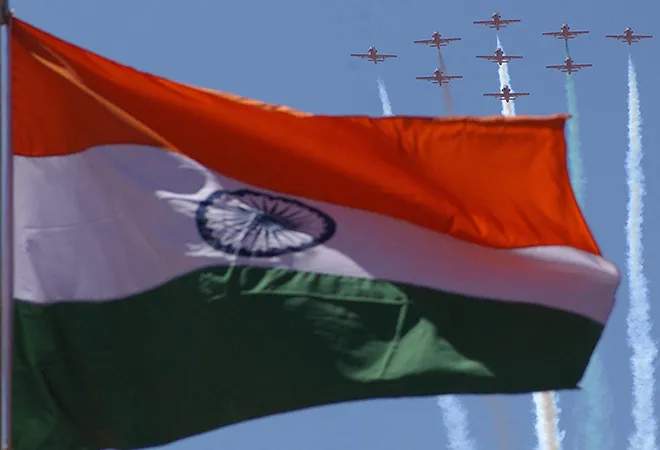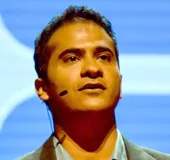
Michael Wood’s epic BBC documentary, Story of India, chronicles his journey across the Indian subcontinent, lauding India’s antiquity, its traditions and cultures from days of yore and acknowledging its status as the cradle of one of the world’s oldest civilisations. He says, “As the brief heyday of the West draws to a close, one of the greatest players in history is now rising again.” This marked a perfect segue from culture to commercial as India began the 21st century as one of the leading players in the Global South, rising slowly but firmly into the higher echelons of the economic powerhouses.
The Cold War ended in the 20th century, but a new form of Manichean duopoly was framed as a race between “the elephant and the dragon”, caricatured to represent two richly endowed civilisation countries, now re-writing their second avatar and their meteoric rise in their economic conquests. India and China were part of BRIC and then later BRICS—the Goldman Sachs codified term, an acronym for Brazil, Russia, India, China and then new entrant South Africa—alluding to the burgeoning economies of the Global South that would script their own economic glories and seal their place in the pantheon of powerhouses.
Since then, hagiographies have been written, paeans have been sung and prognostications have been made of when India would catch up, perhaps, even dislodge other G7 countries and adopt the mantle of “superpower”.
India and China were part of BRIC and then later BRICS—the Goldman Sachs codified term, an acronym for Brazil, Russia, India, China and then new entrant South Africa—alluding to the burgeoning economies of the Global South that would script their own economic glories and seal their place in the pantheon of powerhouses.
While India’s burgeoning economy, largely thanks to its demographic dividend being under 35 years of age—the core working population—the South Asian giant has the catalyst to be at the highest echelons of economic hegemons. All this while, China, as a result of decades of the state run One Child Policy, finds itself with an aging population, which translates to higher costs to the state in the form of pensions and healthcare. Furthermore, there is the worry of slowdown and inability to both dislodge the United States, all while continuing to keep ahead of India.
While there is certainly a method to the madness in being sanguine about India, however, take that with a giant grain of salt, so sacrosanct that Mahatma Gandhi marched for it. The traditional powers of the 20th century and Mearsheimer concept of great powers—such as the United States, and erstwhile USSR, its successor Russia and now China—have all have expanded their power bases through geopolitical and military posturing.
As this author had written earlier, “The post-war global economy saw the creation of the Bretton Woods system with Washington playing a key role in shaping multilateralism. American foreign policy’s shibboleth has long espoused a sense of involvement in world affairs. If there was communism, it became Washington’s concern to preclude its pervasive effect; if there was lack of democracy, Washington got involved; if there was suppression of dissent, dictatorship brewing, rioting in political capitals, it meant it aroused Washington’s ire”.
Great Power politics
While the Cold War epitomised Mearsheimer’s great power competition, it saw two Brobdingnagian nuclear powers protect their political ideologies at all costs. For Washington, it was the sacrosanctity of democracy and precluding the pervasive spread of communism; hence getting involved with Vietnam and Korea; propping up of dictators such as Mobutu Sese Seko, Augusto Pinochet; and even the aligning with military dictators in Pakistan—all for being convinced about their supposed support against communism. Moscow did the same in building client states in East Europe through the Warsaw Pact and invading Afghanistan in order to intervene in the Afghan Civil War to maintain a friendly socialist government at its older borders.
China’s presence extends as far as investments in the Central Business District in Melbourne, Australia to investments as far as the emerging markets in Latin America and a military base in Djibouti, in the Horn of Africa.
China’s assertiveness has come through its economic engagement right from the Belt and Road Initiative—its ‘New Silk Route’—the geoeconomic project to economically and physically link China to markets in Central Asia and cajole smaller states through enticing loans for construction, or through the Shanghai Cooperation Organisation (SCO), dubbed the “alliance of the East”, due to its growing centrality in the Asia-Pacific, and seen as the primary security pillar of the region or through the Asian Infrastructure Investment Bank (AIIB). China’s presence extends as far as investments in the Central Business District in Melbourne, Australia to investments as far as the emerging markets in Latin America and a military base in Djibouti, in the Horn of Africa.
India, on the other hand, has never truly exerted itself beyond its neighbourhood, with the exception of the 1971 Bangladesh Liberation War, and when New Delhi sent the Indian Peacekeeping Forces (IPKF) to Sri Lanka in the late 1980s a gross miscalculation, that would be dubbed as India’s Vietnam, and other historic UN peacekeeping missions.
With the shifting sands in Afghanistan, India remains concerned about regional security, but has done so without any boots on the ground, largely due to this doctrine that is deep rooted in strategic autonomy and aversion to getting involved in external conflicts. While President Biden may eschew a path of nation building, publicly stating that it no longer remains a priority for the US, nation building has been the hallmark of India’s involvement in Afghanistan by way of significant infrastructure investments totaling US $3 billion (INR 224 crore), including the construction of a new parliament building, later inaugurated by Prime Minister Modi in Kabul in 2015 and the Salma Dam in 2016. India has significantly contributed to Afghan development by providing scholarships to students; enabling food assistance; electrification; and building dams, roads, highways, schools, and hospitals.
Friends with everyone, allies with no one
New Delhi thinks and feels very differently, India’s outlook is one that is guided by ‘friends with everyone, allies with no one’. At the time of Independence, the founding Prime Minister Jawaharlal Nehru made a conscious choice to not just stay “non-aligned” as part of the Non-Aligned Movement, but chose to eschew western capitalism for a more Fabian socialist structure. Nehru’s aversion was strongly towards a sense of autonomy, one that believed in not trading one set of western faces (given India’s colonial past with the erstwhile British East India Company) with another set of western faces in American corporations, especially in a fledgling democracy that was left sick at birth and having just come out of a bloody partition.
The domestic counterpart to the IFS, the Indian Administrative Service (IAS), remains the most sought-after service, a priority from the early days of Independence, when nation building at home was prioritised over lofty foreign policy ideals.
Many have critiqued India for having a pusillanimous foreign policy, espoused by the Sanskrit phrase “Vasudeva Kutumbakam” credo, which Prime Minister Narendra Modi and other government officials have invoked many times, referring to “the world is one family”, a phrase that international theorists would both scoff at for the idealistic naivety and excoriate for its lack of pragmatism.
Furthermore, for a country of India’s size, talent and burgeoning population, the Ministry of External Affairs (MEA) has around only 900 diplomats serving its highest echelon in the Indian Foreign Service (IFS). That’s the same size as countries such as New Zealand and Singapore, which have a population of around 5 million people. Powerhouses like China and the United States lead the diplomatic corps with the most missions and diplomats, a club that India would naturally aspire to be part of.
There is much to unpack with why a country as large as India with talent oozing, has so few representing it in a formal capacity overseas. A lot has to do with the archaic British-civil era based structure and examination, the funding for the MEA, but those topics to be unpacked on a different day. In a nutshell, the domestic counterpart to the IFS, the Indian Administrative Service (IAS), remains the most sought-after service, a priority from the early days of Independence, when nation building at home was prioritised over lofty foreign policy ideals.
On the economic front, India still has a herculean task ahead of with significant reforms needed particularly in land, labour and tax reforms and building up a manufacturing sector that has long played second fiddle to the services sector, as India moved from agrarian to services to diversify its coffer earnings, skipping the farm to factory model that made China the behemoth that it is today.
India today finds itself in a dangerous neighbourhood, this sans the imbroglio in Afghanistan. The country has two nuclear adversaries in Pakistan and China, one fuelled by historic animosity, while the other views India as a strategic nuisance.
Lastly, Geoffrey Blainey’s book, The Tyranny of Distance, gives the best clue as his work speaks about how Australia’s geographic isolation shaped its national identity. The United States too, with the two largest moats on either side of its coast, added to a sense of distance from troubled zones and allowed for stability. India today finds itself in a dangerous neighbourhood, this sans the imbroglio in Afghanistan. The country has two nuclear adversaries in Pakistan and China, one fuelled by historic animosity, while the other views India as a strategic nuisance. Both Islamabad and Beijing regard each other as “all-weather allies” and both will likely continue to preclude India's strategic rise.
Beyond the geopolitical, economic and historic dissection, there is another uncomfortable truth. If a country’s identity, like an individual identity, has a strong sense of personality in its external engagement, then one would look at India as the pleasant social introvert at major gatherings, making conversations with everyone, but aligning firmly with no one.
New Delhi’s immediate goals may lie in not having any grand superpower interest, at least all the science would point to that.
The views expressed above belong to the author(s). ORF research and analyses now available on Telegram! Click here to access our curated content — blogs, longforms and interviews.




 PREV
PREV


